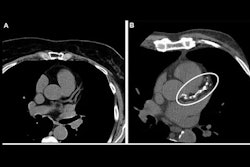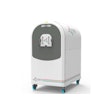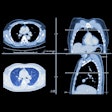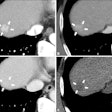A group in South Korea has developed a deep-learning model that can predict coronary artery calcium (CAC) scores from chest x-rays, according to research presented at the Society of Cardiovascular Computed Tomography (SCCT) annual meeting.
"The deep-learning model effectively classified the CACs from [chest x-rays], especially for cases of severe calcification," noted lead author Hyung-Bok Park, MD, PhD, of Catholic Kwandong University College in Incheon, South Korea, and colleagues.
Calcium scores are derived from chest CT scans and are based on the amounts of calcium deposits in the coronary arteries. These deposits are associated with atherosclerosis and increase the risk of heart attack and stroke. Thus, CAC scores are recommended in clinical guidelines to establish risk in individuals for coronary artery disease.
However, chest CT is more expensive than chest x-ray and involves a higher radiation dose for patients, the authors noted. In this study, the group leveraged recent advances in AI to develop and validate a deep-learning model for predicting CAC score categories from chest x-rays.
The researchers included 10,230 patients with available chest x-rays and CAC scores obtained within six months. They first trained three models based on CAC score thresholds (0, 100, and 400) to distinguish zero from non-zero CAC scores, CAC scores of <100 and ≥100, and CAC scores of <400 and ≥400. These thresholds indicate higher risk as they increase.
Park and colleagues then incorporated clinical factors, including age, sex, and body mass index, into the final chest x-ray fusion models and further trained the models. All models were evaluated using 10-fold cross-validation, and external validation was also performed, the group noted.
According to the results, the CAC score classification performance of the best performing deep-learning model was promising, with areas under the curve (AUCs) of 0.74 (zero vs. non-zero), 0.75 (100 vs. ≥100), and 0.79 (<400 vs. ≥400).
In addition, the accuracy of the model further improved upon the fusion of clinical factors, with AUCs of 0.77, 0.79, and 0.82 for the same CAC score categories. Finally, the external validation results were consistent, with AUCs of 0.78, 0.79, and 0.81, the group reported.
"This approach can cost-effectively improve coronary artery disease risk assessment and support clinical decision-making while minimizing radiation exposure," the group concluded.





















